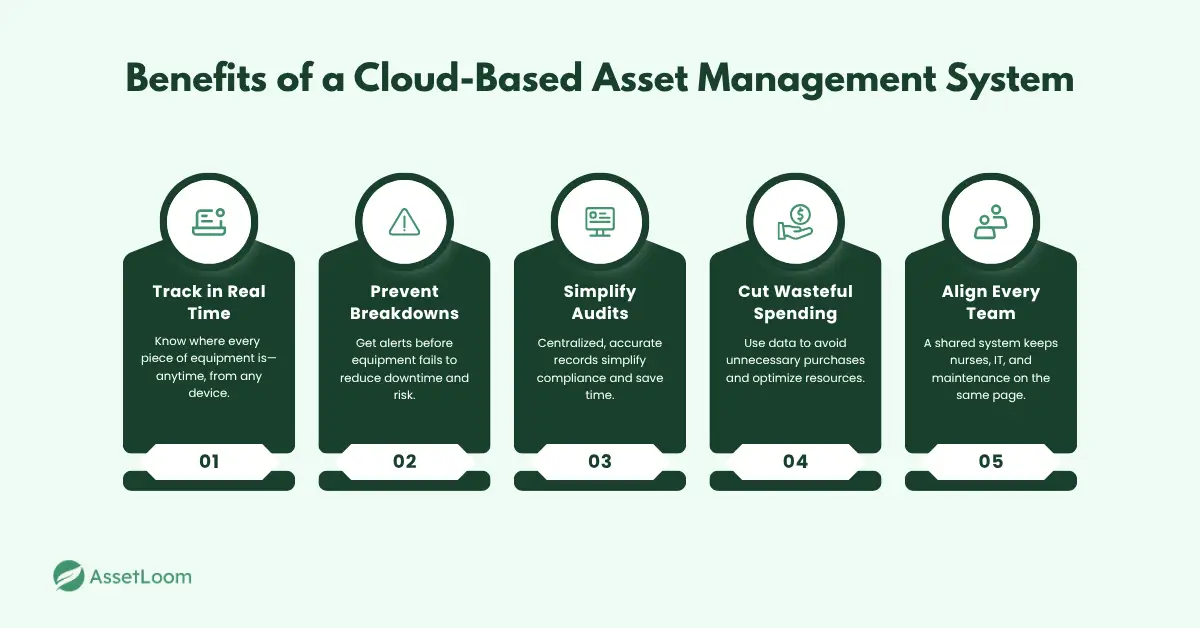How Healthcare Teams Benefit from a Cloud-Based Asset Management System
Discover how a cloud-based asset management system helps healthcare teams track equipment, cut costs, improve maintenance, and stay ready for audits.
In healthcare, time matters—and so does knowing where your equipment is. But too often, staff waste valuable minutes searching for a missing monitor, scanner, or infusion pump that "was just here a second ago."
It’s not just frustrating. It slows down care, throws off schedules, and adds stress to teams that are already stretched thin.
The problem? Many hospitals and clinics still rely on outdated tracking tools, like spreadsheets, sticky notes, or hallway guesswork. That’s where a cloud-based asset management system comes in.
It gives you a live, accurate view of every asset across every department, all in one place. No more guesswork. No more chaos.
Let’s break down how this one upgrade can make a big difference in how healthcare teams work every day.
See Where Everything Is—Anytime, Anywhere
In healthcare, every second counts—and knowing exactly where your equipment is can be the difference between timely care and costly delays. The reality is, assets like infusion pumps, portable monitors, or even wheelchairs often move quickly between departments, floors, or buildings. Without a reliable tracking system, it’s easy for them to disappear from sight, causing wasted time and frustration.
A cloud-based asset management system solves this by providing up-to-the-minute visibility of every asset, no matter where it is. Because the system is cloud-powered, staff can access it securely from any device, whether they’re on a different floor, in a remote clinic, or even working from home. This means a nurse in the ER (emergency room) can instantly locate a critical ventilator at a sister hospital, or a technician can check which devices are available before dispatching maintenance.
This kind of transparency doesn’t just speed up workflows; it improves patient outcomes by reducing wait times for essential equipment. It also supports better resource sharing across departments or facilities, preventing unnecessary purchases and making the most of what you already have.
In short, real-time location tracking helps healthcare teams respond faster, plan smarter, and work more efficiently—all crucial in an environment where every minute matters.
Stay Ahead of Repairs and Maintenance
In healthcare, equipment downtime isn’t just inconvenient—it can put patient safety at risk. Imagine a vital device failing in the middle of a procedure or a diagnostic machine breaking down right before a critical test. These scenarios cause delays, rescheduling, and sometimes even jeopardize care quality.
A cloud-based asset management system helps prevent this by tracking usage, wear, and maintenance schedules in real time. Instead of waiting for something to break, the system sends automatic alerts when a device is due for preventive maintenance or calibration. This proactive approach reduces unexpected failures and keeps equipment running smoothly.
Beyond safety, planned maintenance means fewer emergency repairs that disrupt staff and operations. It also extends the lifespan of costly medical devices, protecting your investment over the long term.
Plus, because the data is stored in the cloud, maintenance teams can access complete service histories from anywhere. This makes it easier to diagnose recurring problems, prioritize repairs, and ensure compliance with manufacturer guidelines and regulations.
By staying ahead of repairs, healthcare teams can focus more on patient care and less on firefighting equipment issues.
Be Ready for Audits Without the Stress
Healthcare facilities face strict regulations—from HIPAA to Joint Commission standards—that require thorough tracking and documentation of equipment. Audits can be overwhelming, especially when records are scattered across spreadsheets, paper logs, or multiple disconnected systems.
A cloud-based asset management system simplifies this process by keeping all asset data centralized, accurate, and instantly accessible. Every piece of equipment’s usage, maintenance history, and compliance status is logged automatically in one place. When auditors come knocking, you can pull up the exact reports they need in seconds—no digging through filing cabinets or chasing down missing paperwork.
This not only reduces the time and effort spent on audits but also lowers the risk of penalties or delays caused by incomplete records. It gives your team confidence that you’re meeting regulatory requirements consistently.
Additionally, the system’s real-time updates ensure that records are always current, so compliance isn’t just something you scramble for during audit season—it’s baked into everyday operations.
By removing the headache of audits, a cloud-based asset management system lets healthcare teams focus more on delivering quality care, rather than worrying about paperwork.
Spend Less on Equipment You Don’t Need
Healthcare budgets are tight, and buying new equipment is always a big decision. Yet, many facilities end up purchasing devices they don’t really need, either because existing assets are underused or simply lost in the shuffle.
A cloud-based asset management system helps you get a clear picture of how your equipment is actually being used. By tracking utilization rates and location data, the system shows which devices are sitting idle and which are in constant demand.
This insight allows healthcare teams to reallocate resources more efficiently—moving underused equipment where it’s needed most instead of spending money on new purchases. It also helps prevent duplicate orders, saving thousands of dollars every year.
Beyond cost savings, better asset visibility means improved planning. You can forecast when equipment will need to be replaced or upgraded, aligning purchases with actual needs rather than guesswork.
In the end, smarter equipment management means your facility spends less, uses assets better, and stays financially healthy without compromising patient care.
Keep Everyone on the Same Page
In healthcare, many teams rely on each other—IT, clinical staff, maintenance, procurement—and communication gaps can slow things down. When equipment breaks or needs to move, delays happen because information isn’t shared quickly or clearly.
A cloud-based asset management system acts as a central hub where everyone can see the same up-to-date information. Nurses know which devices are available. IT can flag issues instantly. Maintenance teams get notified as soon as repairs are needed. Procurement can track inventory levels without guessing.
This shared visibility reduces miscommunication and speeds up decision-making. Instead of waiting for emails or calls, teams can act immediately based on reliable data. This not only improves operational efficiency but also helps avoid errors that could impact patient care.
By keeping everyone connected through a single system, healthcare teams work smoothly, faster, and with less frustration.

Read also: Top 10 Cloud Asset Management Software for Modern Businesses [2025 Updated]
A Quick Example: What This Looks Like in Real Life
Imagine a busy hospital with multiple departments and hundreds of devices moving all day. One day, the emergency room urgently needs a portable ventilator, but the usual one is missing.
With a cloud-based asset management system, the ER nurse quickly logs in from her tablet, checks the real-time dashboard, and sees that another ventilator is currently idle in a nearby recovery ward. She requests it, and the logistics team immediately picks it up and delivers it—no frantic searching or phone tag required.
Meanwhile, the system has already flagged the missing ventilator for follow-up. The maintenance team finds it in a different building, running a scheduled test, and updates its status in the system.
Thanks to clear communication and real-time tracking, critical care continues smoothly without delay, and no equipment is lost or forgotten.
This simple example shows how cloud technology helps healthcare teams save time, reduce stress, and focus on what matters most—patient care.
Conclusion
Managing medical equipment in healthcare is complicated, and the stakes are high. When tools go missing or break down unexpectedly, it’s not just a headache—it affects patient care, staff efficiency, and budgets.
A cloud-based asset management system might seem like a simple tech upgrade, but it’s actually a game-changer. It puts real-time information at your fingertips, helps prevent costly downtime, keeps audits stress-free, and saves money by making every piece of equipment count.
For healthcare teams aiming to work smarter—not harder—this technology isn’t just nice to have. It’s becoming essential.
If your hospital or clinic still relies on spreadsheets or paper logs, it’s time to consider a cloud-based system. The difference it makes? More control, less chaos, and better care for every patient.

Subscribe for Expert Tips and Updates
Receive the latest news from AssetLoom. right in your inbox

